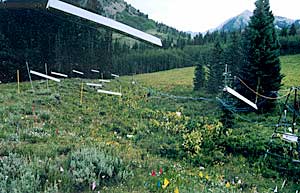|
HOME | SEARCH | ARCHIVE |
|
New research raises and answers questions about the impact of climate change on ecosystems
By Diane Ainsworth, Public Affairs
| |
|
27 SEPTEMBER 00 | High on the western slope of the Colorado Rocky Mountains, at 9,600 feet above sea level, Berkeley ecologist John Harte, a professor in the Energy and Resources Group in the College of Letters and Science, is baking five 330-square-foot plots of ungrazed montane meadow with infrared heaters.
His field experiment to understand how a subalpine meadow ecosystem with roughly 100 species of plants responds to climate warming is providing insight into a global scale problem: how global warming is affecting earth's ecosystems.
Climate modelers predict that continuing buildup in the atmosphere of greenhouse gases such as carbon dioxide and methane will increasingly raise the planetary temperature, resulting in as much as a 5-degree Centigrade temperature rise by the century's end. Possible consequences include a rise in sea level, increased frequency and intensity of droughts and storms, and more and more fire seasons like the recent one in the West. Less dramatically, climate change may cause major changes in the planet's ecosystems.
But even subtle ecosystem changes, like shifts in boundaries between different habitat types, can have consequences. Not only for the local plant and animal life, Harte said, but for the very functions that ecosystems carry out, which, on a global scale, make the planet habitable for all of life. Among the many functions that ecosystems perform, maintenance of a favorable climate is Harte's primary interest.
The impact of ecosystems on global warming
Current climate models, he pointed out, are based on scientists' best understanding of climate physics, but they don't take into account the huge effect changing ecosystems can exert on climate. An ecosystem's influence can affect the climate in positive and negative ways, either enhancing or mitigating global warming.
Terrestrial ecosystems, for instance, store a large quantity of organic carbon, mostly in soils and vegetation; the total amount is roughly four times the carbon dioxide in our atmosphere, said Harte, who holds a joint appointment in Environmental, Science and Policy Management. If, as a result of climate warming, a meadow was to release even a small fraction of stored carbon as carbon dioxide, the increase of this greenhouse gas in the atmosphere would be sizeable. But until scientists understand more about these responses to rising temperatures, their ability to accurately forecast global warming will fall short of the mark.
A changing landscape: From forbs to sagebrush
Harte's experimental heating experiment, now in its 10th year, is beginning to shed light on this complex issue. Heating has increased the growing season length in the heated plots by causing snowmelt to occur about two weeks earlier. It has also warmed the soils by 1-to-2 degrees Centigrade and reduced soil moisture by about 20 percent. More significantly, these physical changes have caused shifts in the abundance of plants growing in the heated plots; sagebrush has expanded at the expense of forbs, which are flowering plants that give high mountain meadows their distinctive beauty during the summer.
The spread of sagebrush was accompanied by a decrease in overall photosynthesis rates in the heated plots, Harte said. Consequently, less organic matter, in the form of leafy litter, was entering the soil. Reduced carbon storage in the soil increased the net flow of carbon dioxide from the ground to the atmosphere. In a small scale experiment like Harte's, this has no noticeable effect; but if multiplied by a large area of land, the amount of carbon dioxide released into the atmosphere could be significant.
Another change that has been occurring in this high altitude meadow is an increase in surface heating. Sagebrush absorbs more sunlight than the flowery forbs that it has displaced; the magnitude of that effect over a large expanse of land isn't yet understood and could have a dramatic impact in influencing regional climate.
Altering earth's very nature
The ecological changes Harte and his students have observed have the potential of altering the very nature of earth's montane habitat as they turn from flowery subalpine meadows to dry mosaics of sagebrush and grass. These shifts will affect land use patterns and the livelihood of mountain residents. Colorado ranchers, who use the lush mountain slopes to feed cattle, will be hard-pressed to find enough forage for their herds. The recreational value of montane landscapes will be reduced as well, although the effects of climate change on montane wetlands and forests have not been determined.
Worse yet, the diversity of life in the mountains will likely diminish over time, although the rate at which species may be lost is not understood yet.
Earlier snowmelts and drier summer soil conditions will stress agriculture downstream of the high mountains, where farmers rely on the water storage provided by late-melting snowpacks, Harte said. But the most far-reaching effects of ecosystem change to climate may be on climate itself, as changes in the chemistry of this landscape and the atmosphere around it kick in over large areas of land.
Home | Search | Archive | About | Contact | More News
Copyright 2000, The Regents of the University of California.
Produced and maintained by the Office of Public Affairs at UC Berkeley.
Comments? E-mail berkeleyan@pa.urel.berkeley.edu.
